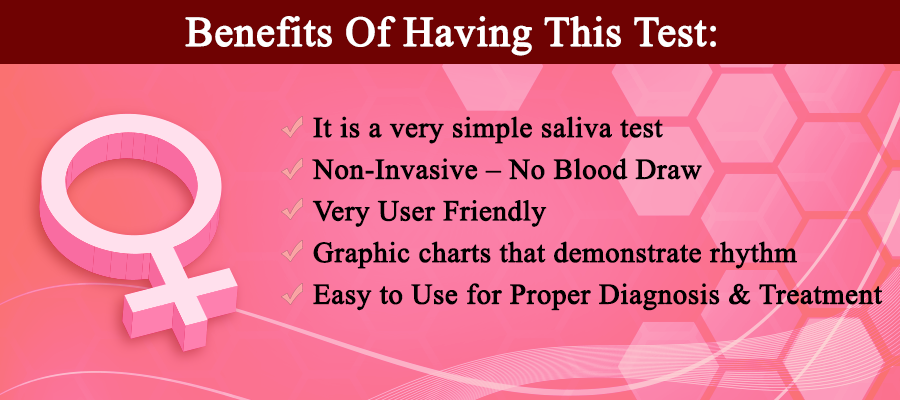![]()

As a clinician, some of the most common health problems I see are related to sex and stress hormone levels. This kind of issue leads to major problems with menstruation, pre and post menopausal symptoms. They are also major risk factors for breast, uterine and ovarian cancer in women and prostate cancer in men.
Many women struggle with fluctuating levels of estradiol, progesterone and testosterone. When these levels lack stability and are sliding around it can cause a host of major health issues that affect menstrual cycle, appetite level, mood, sex drive and sleep patterns.
What Most Doctors Do Wrong:
When most doctors order a hormone test they are looking at hormones at a static period of time. The challenge with this is that these hormones should naturally fluctuate in a rhythmic cycle over a normal 28 day menstrual cycle.
When we only test hormones at one period of time we are not going to get an accurate understanding of the individual’s unique rhythm and imbalances. This leads to inaccurate diagnosis and improper treatments.
Estrogen Quotient Testing:
Estrogen is an essential hormone for the function and well-being of the female and at a reduced level the male body. Estrogen can be broken down into 3 major subtypes. The ratios of these subtypes give us a lot of critical health information that correlate to the risk of someone developing a hormone sensitive cancer.
Estrogen is considered a growth and development hormone that is manufactured from cholesterol by a woman’s ovaries. It is also produced in lower concentrations in the fat cells and the adrenal glands in both males and females. The estrogen circulates in the blood and passes in and out of all the organs and tissues and is eventually metabolized by enzymes in the liver.
Three Major Estrogens:
E1 or Estrone: This is the main form of estrogen produced during menopause. This is produced mainly in your liver and fat cells. Since toxins such as xenoestrogens, heavy metals, and other pollutants that directly affect hormone levels are stored in your liver and fat cells, individuals with higher levels of toxicity have altered and contaminated forms of estrone.
E2 or Estradiol: This is the predominant estrogen produced during reproductive years and it is ten times more potent than E1 and about 80 times stronger than E3. Elevations in estradiol are linked to cancers of the breast, ovaries and uterus.
E3 or Estriol: This is the protective form of estrogen that reduces cellular growth factors and other estrogens. Estriol reduces the more aggressive estradiol and protects against radiation induced cancer of the breast.
We should normally have a ratio of 90% Estriol, 7% Estradiol and 3% Estrone in what is referred to as the Tri-Estrogen Formula.
The Estrogen Quotient:
The overall ratios of these hormones are titled your Estrogen Quotient or EQ. This formula was developed by estrogen researcher Dr Henry Lemon. He discovered that the greater the amount of cancer protective E3 is present in comparison to the growth promoting E1 and E2, the lower the risk of estrogen sensitive cancer development.
The EQ is found through the following formula:
Total E3/(Total E1+Total E2)
If the EQ is below 1.0, the risk of Breast Cancer is higher than that of the individual whose EQ is above 1.0. The optimal ratio that is considered most protective to breast tissue is an EQ that is greater than 1.5. This quotient can also be useful to determine other aspects of hormonal health and risk of autoimmunity.
Estrogen/Progesterone Ratios:
Progesterone is an antagonist to estrogen. Estrogen stimulates growth and when unchecked can lead to breast cysts. Progesterone modulates growth and protects against breast cysts. Estrogen enhances salt and water retention while progesterone balances this by acting as a natural diuretic.
Estrogen dominance is a condition where there is far more estrogen than progesterone. This imbalance is associated with breast and endometrial cancers as estrogen promotes growth and progesterone modulates growth. Studies have shown that pre-menopausal women deficient in progesterone had a 5.4 times greater risk of breast cancer compared to women with normal estrogen/progesterone balance.

Why I Love This Test
This test also measures cortisol and DHEA cycles. These play a very intimate role with the estradiol/progesterone/testosterone balance. You really need to understand the cortisol and DHEA rhythm in order to accurately understand imbalances in the sex hormone production and secretion.
As a clinician, I think this test gives me the full package as far as hormonal output goes. If you are suffering with female related disorders or have a family history of these, I would highly recommend getting this test done.
Total Cost: $351.00
If you live in New York or New Jersey, some lab testing may not be able to be completed. Please contact our team at (847) 222-9546 to verify that this request can be fulfilled.


Fortunately, because of the many thousands of newsletter readers and social media followers, my team has been able to network with a great lab distributor and get the best possible pricing for everyone. The retail value (using market value and insurance based rates) is highly inflated and driving up the cost of health care. This is the old, archaic method that many people are still using and paying way more for insurance and co-pays than they really should be. Many intelligent people are saving insurance premium dollars and turning to pay by order labs such as DirectLabs and others. These skip the middle man (doctors’ visits) and cut down costs for the patient.

If the test requires blood work you can take your kit to any local lab and have the trained professional take your blood and fill out the kit and send it in the mail.
Urine and blood prick tests can all be done in the comfort of your home and sent into the lab with the mailing slip in your kit. All instructions will be sent to you with the kit. It is a very simple process that most anyone can figure out. The lab also has a customer service phone # if any help is needed.




